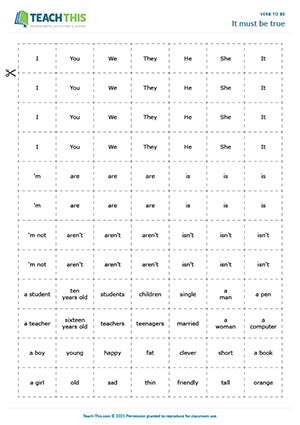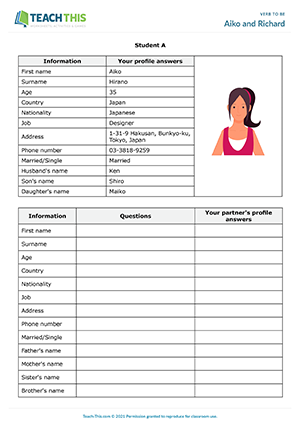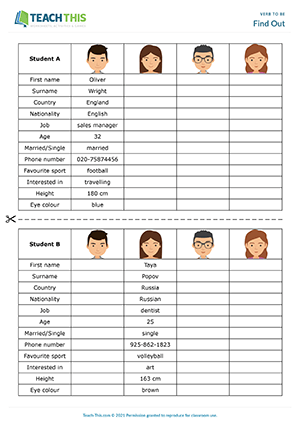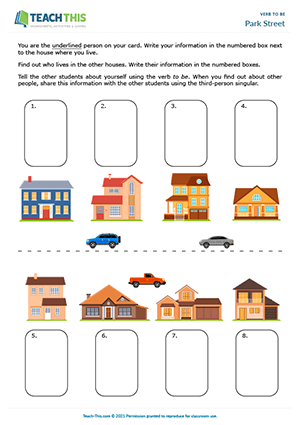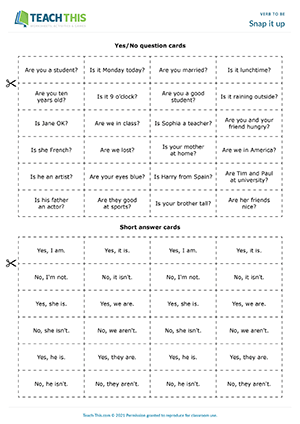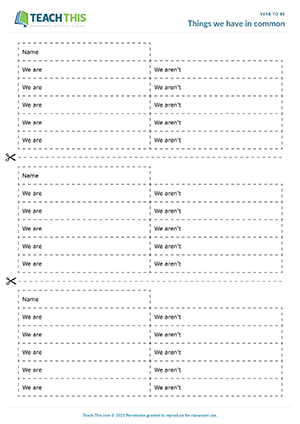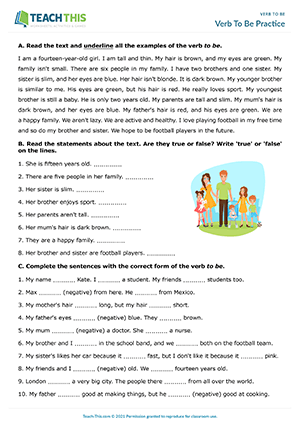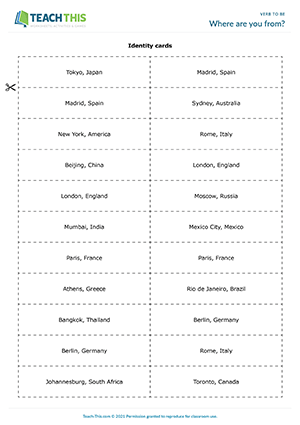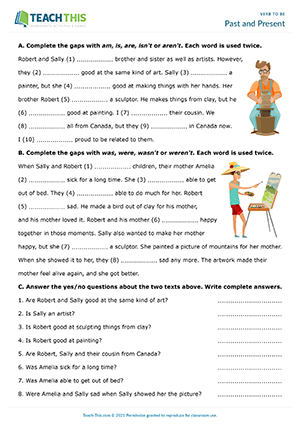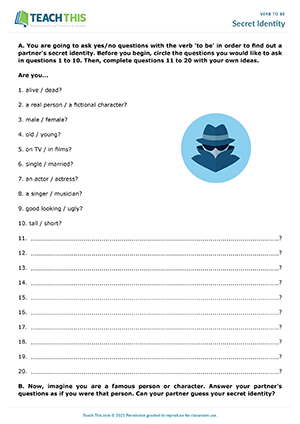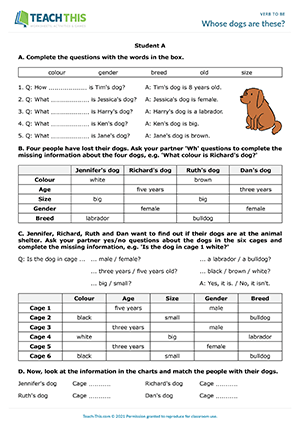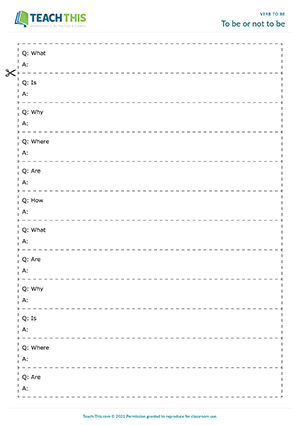Here is a free verb to be game for beginners to help them practice forming affirmative and negative sentences with the present simple. This game also helps students understand subject-verb agreement and how to use the verb to be to make true statements. The first player looks at their cards and makes a true affirmative or negative sentence by placing three cards face up on the table and reading the sentence aloud, e.g. 'I’m a student.' If the sentence is formed correctly and true, the player scores a point. Players may indicate to things or people in the classroom to help justify a sentence as being true. The player then takes three more cards from the pile. The next player then puts down three cards and makes a true sentence, and so on. If a player cannot make a true sentence, they replace one of their cards and miss a turn. The player with the most points at the end of the game wins.
In this useful verb to be speaking activity, students ask and answer basic personal information questions with the verb to be in order to complete a profile. Students look at the profile at the top of the worksheet and take on the role of that person. Their task is to write down personal information questions with the verb to be in order to find out information about a classmate's profile. In two groups, students look at the information in the second chart and write a question for each prompt using the verb to be. Afterwards, students pair up with someone from the other group and take turns asking the questions to their partner and completing the profile with their answers.
In this engaging verb to be game, students race to complete a bingo card by asking and answering Are you...? questions. Each square on the bingo card contains an affirmative or negative present simple sentence with the subject (name) missing. The students' task is to complete the sentences by asking present simple yes/no questions with the verb to be. For example, if a sentence reads '... is good at skating', a student asks 'Are you good at skating?' When a classmate replies 'Yes, I am', the student writes their name in the blank space, e.g. 'Joshua is good at skating.' Each time a student speaks to a classmate, they are only allowed to ask one question. The first student to get five names in a row wins the game.
In this productive verb to be speaking activity, students practice the various uses of the verb to be by asking and answering questions in order to complete a chart with information about four people. Students take on the role of the person in their chart and read through their information. Students then go around asking and answering verb to be questions with the people in their group, completing their chart with the corresponding information. When have finished, they check their answers by comparing worksheets.
In this enjoyable verb to be speaking activity, students practice exchanging information about different people living on a street. The aim of the activity is to find out who lives in the other houses on the street and to write all the details on the worksheet. To do this, students take on the role of the person on their card and talk to the other members of their group, exchanging information using the verb to be, e.g. 'I’m Chloe. I’m at house number 1 with Leo. I’m 32 years old and Leo is 33.' When the students find out about other people who live on the street, they pass the information on to other students using the third-person singular, e.g. 'Alex is at house number 2. He is 30 years old. He is single.' When everyone has finished, review the answers with the class.
In this fast-paced verb to be game, students play snap by matching yes/no questions with the verb to be to short answers. In pairs, both students turn over a card from their pile at the same time and place them on the table next to each other. If the yes/no question and short answer match, the first student to say 'Snap' scores a point. Students then pick up their own cards, shuffle their pack, and play again. Students do not pick up their partner's cards. If the question and answer don't match, students continue turning over cards until a matching pair comes up. If a student says 'Snap' when the question and answer don't match, the other student gets a point and the game continues. The first student to get 15 points wins the game.
In this imaginative verb to be game, students write We are and We aren’t sentences about things they have in common and play a matching game with the sentences. First, students write their name at the top of the card in the space provided. Students then talk to each group member in turn and write a We are... and We aren’t... sentence on their card about things they have in common. No two statements can be the same, so students must vary the information they write and think of something different they have in common each time they change partner. Next, students cut their paper into name cards and sentence cards. Students then play a matching game by taking turns to turn over two name cards and one sentence card. If the sentence is true for the two students whose names have been turned up, the student keeps the sentence card. If the sentence isn't true, the student turns the cards back over and it's the next student's turn to play. The student with the most cards at the end of the game wins.
In this free verb to be worksheet, students practice present simple verb to be subject-verb agreement in affirmative and negative sentences as well as questions and answers. Students begin by reading a text about a family and underlining all the examples of the verb to be in the description. Next, students read statements about the text and mark them true or false. Students then complete sentences with the correct form of the verb to be. Students then move on to do the same with questions and answers. After that, students rewrite sentences, correcting verb to be errors. In the last exercise, students use the singular and plural forms of the verb to be to make sentences about different topics.
In this rewarding verb to be game, students take on the role of someone from another country and talk about the city they are from and their nationality. This game can also be used to practice countries, cities, and nationalities. Students imagine that they are from the city and country on their identity card. Students go around the class using the verb to be to tell their classmates the city they are from and their nationality, according to the country on their card, e.g. 'I'm from Tokyo. I'm Japanese.' The students' task is to listen and try to remember which city each student is from and their nationality. Next, in pairs, students write down where each person is from and their nationality using the verb to be, e.g. 'Max is from Tokyo. He is Japanese.' Pairs score one point for every factually correct sentence and an extra point for the correct use of the verb to be. The pair with the most points wins the game.
This insightful verb to be worksheet helps students practice the past and present simple of the verb to be: am, are, is, was and were as well as their negative forms. First, students complete a text with am, is, are, isn't or aren't. Students then complete another text with was, were, wasn't or weren't. Students then move on to answer comprehension questions about the two texts using the verb to be. Next, students complete another text with the correct form of the verb to be in brackets. Lastly, students write an email to one of the people from the texts using the verb to be forms from the worksheet.
In this entertaining verb to be guessing game, students ask yes/no questions with the verb to be in order to find out a partner's secret identity. First, students circle the questions they would like to ask in questions 1 to 10 on the worksheet and complete questions 11 to 20 with their own ideas. Next, in pairs, each student imagines that they are a famous person or character and answers their partner's questions as if they were that person. One student goes first and asks the questions they have prepared to their partner who responds 'Yes, I am' or 'No, I'm not' accordingly. When the student thinks they know their partner's secret identity, they can make a guess. If the guess is correct, students swap roles. If not, the student continues to ask questions and make guesses until the last question has been asked. Afterwards, there is a class feedback session to find out who asked the most and least questions.
In this comprehensive verb to be information gap activity, students practice asking and answering questions with the verb to be. First, students complete present simple Wh questions with words from a box on the worksheet. Next, students use the questions and answer structures from the first exercise in an information gap activity about four people who have lost their dogs. The students' task is to complete descriptions of the dogs by asking and answering questions with their partner and completing the missing information in the chart. Students then move on to practice yes/no questions with the verb to be in a second information gap activity where the four people want to find out if their dogs are at an animal shelter. Students use yes/no questions from the worksheet to ask about dogs in six cages in the animal shelter. Students complete the missing information in the chart with the answers. Students then look at the information in the chart and match the people with their dogs.
In this creative verb to be game, students write and respond to questions with the verb to be. First, students think of a personal information question beginning with the word on their question slip and write down the next word in the question. Students then pass the slip to the person on their right, who writes the next word and passes it on. The student who writes the last word in the question adds a question mark and hands the question to the next person, who writes an answer underneath, puts the slip in an envelope and takes another slip. This continues until all the slips are complete. Students then take turns taking a slip from the envelope and reading the question and answer to the group members, who each guess which student answered the question. The student who wrote the answer bluffs by guessing another student, but once all the group members have guessed, they reveal it was them. For each correct guess, students score a point. The student with the most points at the end of the game wins.
Latest Free
Resources
- Everyday Objects Bingo
Everyday Objects
Elementary (A1-A2)
- Action Verb Races
Actions
Elementary (A1-A2)
- Birthday Basics
Birthdays
Elementary (A1-A2)
- Sales Phrasal Verbs
Business Phrasal Verbs
Upper-intermediate (B2)
Latest Member
Resources
- Collocations at Work
Business Collocations
Intermediate (B1)
- Etiquette Trivia Board Game
Etiquette and Manners
Upper-intermediate (B2)
- Everyday Objects Vocabulary
Everyday Objects
Pre-intermediate (A2)
- Let's have a talk
Verb-Noun Collocations
Pre-intermediate (A2)



